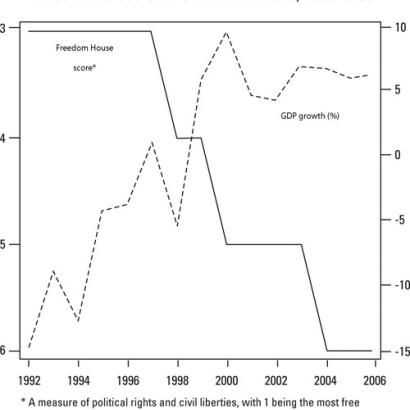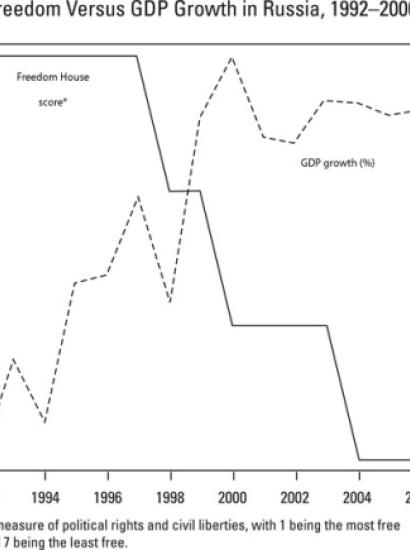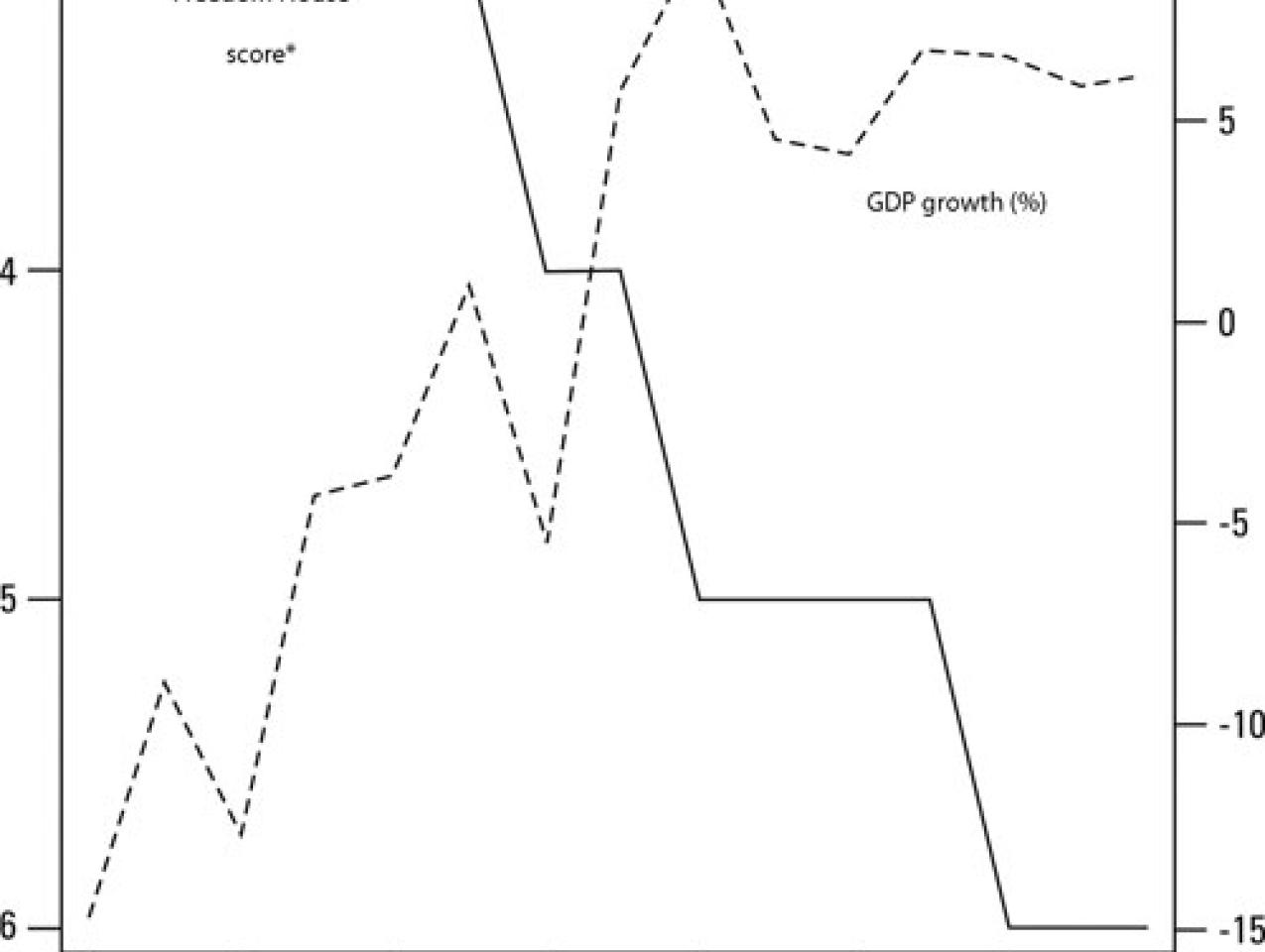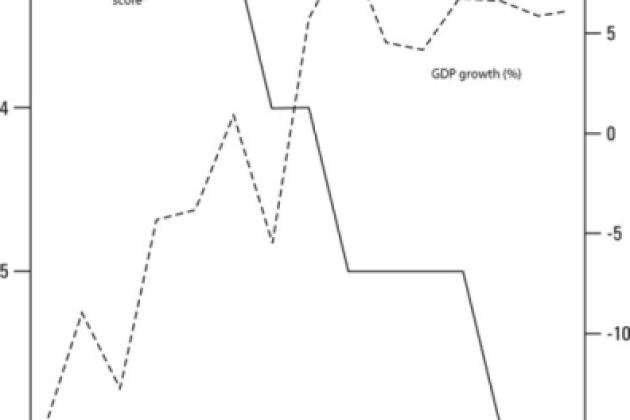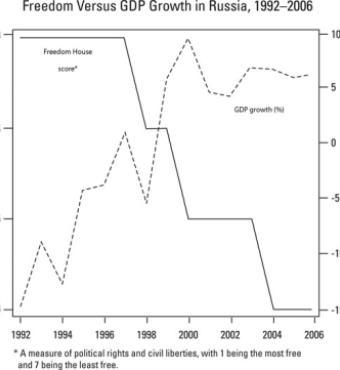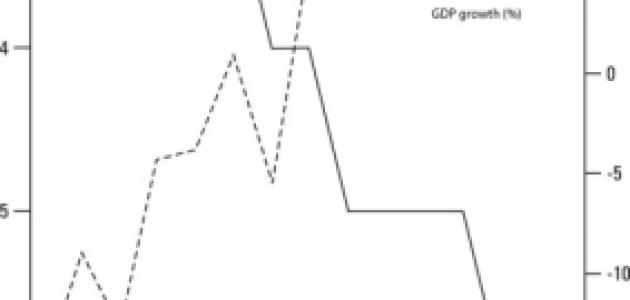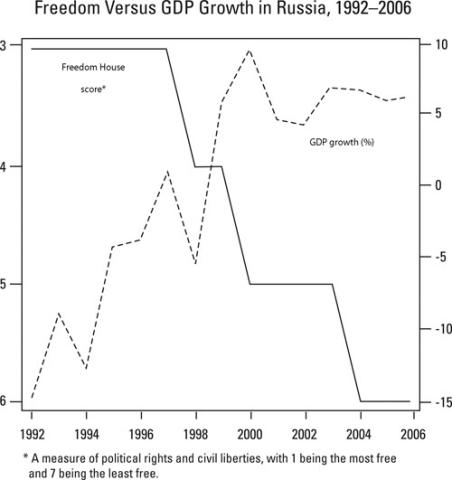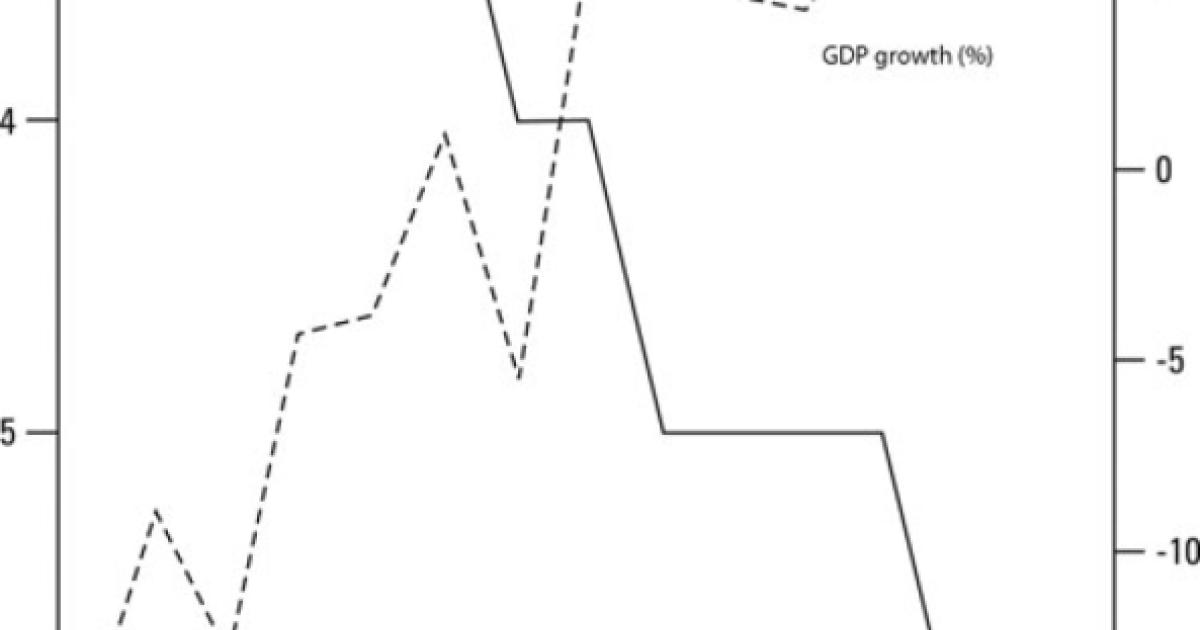- Economics
- Law & Policy
- Regulation & Property Rights
- Energy & Environment
- US
- Contemporary
- Economic
- International Affairs
- US Foreign Policy
- History
The conventional explanation for Vladimir Putin’s popularity is straightforward. In the 1990s, under post-Soviet Russia’s first president, Boris Yeltsin, the state did not govern, the economy shrank, and the population suffered. Since 2000, under Putin, order has returned, the economy has flourished, and the average Russian is living better than ever before. As political freedom has decreased, economic growth has increased. Putin may have rolled back democratic gains, the story goes, but these were necessary sacrifices on the altar of stability and growth. This narrative has a powerful simplicity, and most Russians seem to buy it. Putin’s approval rating hovers near 80 percent, and nearly a third of Russians would like to see him become president for life. Putin, emboldened by such adoration, has signaled that he will stay actively involved in ruling Russia in some capacity after stepping down as president this year, perhaps as prime minister to a weak president or even as president again later on. Authoritarians elsewhere,Nor has public health improved in the past eight years. Despite all the money in the Kremlin’s coffers, health spending averaged 6 percent of GDP from 2000 to 2005, compared with 6.4 percent from 1996 to 1999. Russia’s population has been shrinking since 1990, thanks to decreasing fertility and increasing mortality rates, but the decline has worsened since 1998. An estimated 0.9 percent of the Russian population is now infected with HIV, and rates of infection in Russia are now the highest of any country outside Africa, at least partly as a result of inadequate or harmful legal and policy responses and a decrepit health care system. Life expectancy in Russia rose between 1995 and 1998. Since 1999, however, it has declined to 59 years for Russian men and 72 for Russian women. meanwhile, have held up Putin’s popularity and accomplishments in Russia as proof that autocracy has a future—that, contrary to the end-of-history claims about liberal democracy’s inevitable triumph, Putin, like China’s Deng Xiaoping, has forged a model of successful market authoritarianism that can be imitated around the world.
This conventional narrative is wrong, based almost entirely on a spurious correlation between autocracy and growth. The emergence of Russian democracy in the 1990s did indeed coincide with state breakdown and economic decline, but it did not cause either. The re-emergence of Russian autocracy under Putin, conversely, has coincided with economic growth but has not caused it (high oil prices and recovery from the transition away from communism deserve most of the credit). There is also very little evidence to suggest that Putin’s autocratic turn over the past several years has led to more effective governance than under the fractious democracy of the 1990s. In fact, the reverse is much closer to the truth: to the extent that Putin’s centralization of power has had an influence on governance and economic growth at all, the effects have been negative. Whatever the apparent gains of Russia under Putin, they would have been greater if democracy had survived.
A NURSERY FOR DEMOCRACY
The process of democratization started before Russian independence. After the collapse of the Soviet Union in 1991, Russia started developing all the basic elements of an electoral democracy, including competitive elections for parliament and the presidency and mostly competitive elections for regional governors. Political parties of all stripes, including opposition communist and ultranationalist groups, operated freely, as did nongovernmental organizations (NGOs). Electronic and print media outlets not controlled by the state multiplied.
The re-emergence of Russian autocracy under Putin has coincided with economic growth but has not caused it. High oil prices and recovery from the transition away from communism deserve most of the credit.
Yeltsin was far from a perfect democrat. Still, whatever its warts, the Russian regime under Yeltsin was unquestionably more democratic than the Russian regime today. Although the formal institutional contours of the Russian political system have not changed markedly under Putin, the actual democratic content has eroded considerably.
Putin’s rollback of democracy started with independent media outlets. When he came to power, three television networks—RTR, ORT, and NTV—had the national reach to count in Russian politics. Putin tamed all three, and today the Kremlin controls all the major national television networks. More recently, the Kremlin has extended its reach to print and online media, which it had previously left alone. Meanwhile, Russia now ranks as the third most dangerous place in the world to be a journalist, behind only Iraq and Colombia. Reporters Without Borders has counted twenty-one journalists murdered in Russia since 2000, including Anna Politkovskaya, the country’s most courageous investigative journalist.
Putin has also reduced the autonomy of regional governments. He established seven supraregional districts headed primarily by former generals and KGB officers. These seven new supergovernors were assigned to take control of all the federal agencies in their jurisdictions, many of which had developed affinities with the regional governments during the Yeltsin era.
Putin emasculated the Federation Council, the upper house of Russia’s parliament, by removing elected governors and heads of regional legislatures from the seats they would have automatically taken in this chamber and replacing them with appointed representatives. Regional elections were rigged to punish leaders who resisted Putin’s authority. And in September 2004, in a fatal blow to Russian federalism, Putin announced that he would begin appointing governors. There have been no regional elections for executive office since February 2005.
Putin has also made headway in weakening the autonomy of parliament. Starting with the December 2003 parliamentary elections, he has taken advantage of his control of other political resources (such as NTV and the regional governorships) to give the Kremlin’s party, United Russia, a strong majority in the Duma: United Russia and its allies now control two-thirds of the seats in parliament.
Political parties not aligned with the Kremlin have also suffered. The independent liberal parties, Yabloko and the SPS, as well as the largest independent party on the left, the Communist Party of the Russian Federation, are all much weaker today and work in a much more constrained political environment than in the 1990s. Other independent parties have not even been allowed to register for elections. Potential backers of independent parties have been threatened with sanctions. The imprisonment of Mikhail Khodorkovsky, previously Russia’s wealthiest man and owner of the oil company Yukos, sent a powerful message to other businesspeople about the costs of being involved in opposition politics.
In his second term, Putin decided that NGOs could become a threat to his power. He therefore promulgated a law that gives the state numerous means to harass, weaken, and even close down NGOs considered too political. Perhaps most incredible, public assembly is no longer tolerated. In the spring of 2007, Other Russia, a coalition of civil-society groups and political parties led by the chess champion Garry Kasparov, tried to organize public meetings in Moscow and St. Petersburg. Both meetings were disrupted by thousands of police officers and special forces, and hundreds of demonstrators were arrested—repression on a scale unseen in Russia in twenty years.
In his annual address to the Federation Assembly in April 2007, Putin struck a note of paranoid nationalism when he warned of Western plots to undermine Russian sovereignty. The Kremlin, accordingly, has tossed out the Peace Corps, closed OSCE missions in Chechnya and Moscow, declared persona non grata the AFL-CIO’s field representative, and raided the offices of the Soros Foundation and the National Democratic Institute.
While weakening checks on presidential power, Putin and his team have tabled reforms that might have strengthened other branches of the government. The judicial system remains weak, and when major political issues are at stake, the courts serve as yet another tool of presidential power.
BIGGER IS NOT BETTER
Many of Putin’s defenders, including some Kremlin officials, have given up the pretense of characterizing Russia as a “managed” or “sovereign” democracy. Instead, they contend that Russia’s democratic retreat has enhanced the state’s ability to provide for its citizens. The myth of Putinism is that Russians are safer, more secure, and generally living better than in the 1990s—and that Putin himself deserves the credit. In the 2007 parliamentary elections, the first goal of “Putin’s Plan” (the main campaign document of United Russia) was to “provide order.”
In fact, although the 1990s was a period of instability, economic collapse, and revolutionary change in political and economic institutions, the state performed roughly as well as it does today, when the country has been relatively “stable” and its economy is growing rapidly. Even in good economic times, autocracy has done no better than democracy at promoting public safety, health, or a secure legal and property-owning environment.
The Russian state under Putin is certainly bigger than it was before. The number of state employees has doubled, to roughly 1.5 million. The Russian military has more capacity to fight the war in Chechnya today, and the coercive branches of the government—the police, the tax authorities, the intelligence services—have bigger budgets than they did a decade ago. In some spheres, such as paying pensions and government salaries on time, road building, and educational spending, the state is performing better now than during the 1990s. Yet given the growth in its size and resources, what is striking is how poorly the Russian state still performs. In terms of public safety, health, corruption, and the security of property rights, Russians are actually worse off today than they were a decade ago.
Security, the most basic public good a state can provide for its population, is a central element in the myth of Putinism. In fact, the frequency of terrorist attacks in Russia has increased under Putin. The two biggest terrorist attacks in Russia’s history—the Nord-Ost incident at a theater in Moscow in 2002, in which an estimated 300 Russians died, and the Beslan school hostage crisis, in which as many as 500 died—occurred under Putin’s autocracy, not Yeltsin’s democracy. The number of deaths of both military personnel and civilians in the second Chechen war—now in its eighth year—is substantially higher than during the first Chechen war, which lasted from 1994 to 1996. (Conflict inside Chechnya appears to be subsiding, but conflict in the region is spreading.) The murder rate has also increased under Putin.
Nor has public health improved in the past eight years. Despite all the money in the Kremlin’s coffers, health spending averaged 6 percent of GDP from 2000 to 2005, compared with 6.4 percent from 1996 to 1999. Russia’s population has been shrinking since 1990, thanks to decreasing fertility and increasing mortality rates, but the decline has worsened since 1998. An estimated 0.9 percent of the Russian population is now infected with HIV, and rates of infection in Russia are now the highest of any country outside Africa, at least partly as a result of inadequate or harmful legal and policy responses and a decrepit health care system. Life expectancy in Russia rose between 1995 and 1998. Since 1999, however, it has declined to 59 years for Russian men and 72 for Russian women.
Whatever the apparent gains of Russia under Putin, they would have been greater if democracy had survived.
At the same time that Russian society has become less secure and less healthy under Putin, Russia’s international rankings for economic competitiveness, business friendliness, and transparency and corruption all have fallen. In 2006, Transparency International ranked Russia at its all-time worst, 121st out of 163 countries on corruption, putting it between the Philippines and Rwanda. Russia ranked 62nd out of 125 on the World Economic Forum’s Global Competitiveness Index in 2006, representing a fall of nine places in a year. On the World Bank’s 2006 “ease of doing business” index, Russia ranked 96th out of 175, also an all-time worst.
Property rights have also been undermined. Putin and his Kremlin associates have used their unconstrained political powers to redistribute some of Russia’s most valuable properties. The seizure and then reselling of Yukos’ assets to the state-owned oil company Rosneft was the most egregious case, not only diminishing the value of Russia’s most profitable oil company but also slowing investment (both foreign and domestic) and sparking capital flight. State pressure also compelled the owners of the private Russian oil company Sibneft to sell their stakes to the state-owned Gazprom and Royal Dutch/Shell to sell a majority share in its Sakhalin-2 project (in Siberia) to Gazprom. Such transfers have transformed a once private and thriving energy sector into a state-dominated and less-efficient part of the Russian economy. Under the banner of a program called “National Champions,” Putin’s regime has done the same in the aerospace, automobile, and heavy machinery industries.
Putin decided that NGOs could become a threat to his power. He therefore gave the state numerous means to harass, weaken, and even close down those considered too political.
In short, the data simply do not support the popular notion that by erecting autocracy Putin has built an orderly and highly capable state that is addressing and overcoming Russia’s rather formidable development problems. Putin’s failures in this regard are all the more striking given the tremendous growth of the Russian economy every year since 1999: even with money coursing through the economy, Putin’s government has done no better and sometimes worse a job of providing basic public goods and services than Yeltsin’s government did during the deep economic decline of the 1990s.
A EURASIAN TIGER?
The second supposed justification for Putin’s autocratic ways is that they have paved the way for Russia’s spectacular economic growth. As Putin has consolidated his authority, growth has averaged 6.7 percent—especially impressive against the backdrop of the depression in the early 1990s. The past eight years have also seen budget surpluses, the eradication of foreign debt, the accumulation of massive hard-currency reserves, and modest inflation. The stock market is booming, and foreign direct investment, although still low compared to that in other emerging markets, is growing rapidly. And it is not just the oligarchs who are benefiting from Russia’s economic upturn. Since 2000, real disposable income has increased by more than 10 percent a year, consumer spending has skyrocketed, unemployment has fallen from 12 percent in 1999 to 6 percent in 2006, and poverty, according to one measure, has declined from 41 percent in 1999 to 14 percent in 2006. Russians are richer today than ever before.
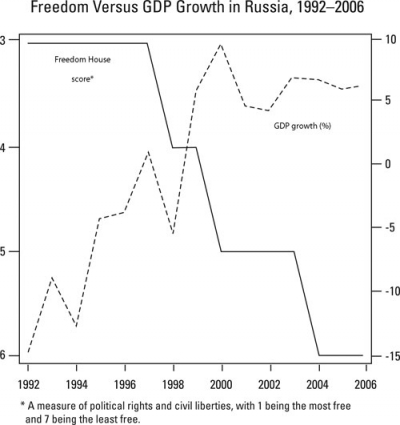
The correlations between democracy and economic decline in the 1990s and autocracy and economic growth in this decade provide a seemingly powerful excuse for shutting down independent television stations, canceling gubernatorial elections, and eliminating pesky human rights groups. These correlations, however, are mostly spurious.
The 1990s were indeed a time of incredible economic hardship. After Russia’s formal independence in December 1991, GDP contracted over seven years, investment was flat, unemployment ballooned, disposable incomes dropped, and poverty levels jumped to more than 40 percent after the August 1998 financial meltdown.
Democracy, however, had only a marginal effect on these economic outcomes and may have helped turn the situation around in 1998. For one thing, the economic decline preceded Russian independence. Indeed, it was a key cause of the Soviet collapse. With the Soviet collapse, the drawing of new borders to create 15 new states in 1991 triggered massive trade disruptions. And for several months after independence, Russia did not even control the printing and distribution of its own currency. Neither a more democratic polity nor a robust dictatorship would have altered the negative economic consequences of these structural forces in any appreciable way.
Economic decline after the end of communism was hardly confined to Russia. It followed communism’s collapse in every country throughout the region, no matter what the regime type. In the case of Russia, Yeltsin inherited an economy that was already in the worst non-wartime economic depression ever. Given the dreadful economic conditions, every postcommunist government was compelled to pursue some degree of price and trade liberalization, macroeconomic stabilization, and, eventually, privatization. During this transition, the entire region experienced economic recession and then began to recover several years after the adoption of reforms. Russia’s economy followed this same general trajectory—and would have done so under dictatorship or democracy.
After the Soviet collapse, Russian leaders had serious policy choices to make regarding the nature and speed of price and trade liberalization, privatization, and monetary and fiscal reforms. This complex web of policy decisions was subsequently oversimplified as a choice between “shock therapy” (doing all of these things quickly and simultaneously) and “gradual reform” (implementing the same basic menu of policies slowly and in sequence). Between 1992 and 1998, Russian economic policy zigzagged between these two extremes, in large part because Russian elites and Russian society did not have a common view about how to reform the economy.
The financial meltdown of 1998 finally put an end to major debate over economic policy in Russia. Because democratic institutions still mattered, the liberal government responsible for the financial crash had to resign, and parliament compelled Yeltsin to appoint a left-of-center government headed by Prime Minister Yevgeny Primakov. The deputy prime minister in charge of the economy in Primakov’s government was a Communist Party leader. Now that they were in power, Primakov and his government had to pursue fiscally responsible policies, especially as no one would lend to the Russian government. So these “socialists” slashed government spending and reduced the state’s role in the economy. In combination with currency devaluation, which reduced imports and spurred Russian exports, Russia’s new fiscal austerity created the permissive conditions for real economic growth starting in 1999. And so began Russia’s economic turnaround— before Putin came to power and well before autocracy began to take root.
Even in good economic times, autocracy has done no better than democracy at promoting public safety, health, or a secure legal and property-owning environment.
First as prime minister and then as president, Putin stuck to the sound fiscal policies that Primakov had put in place. After competitive elections in December 1999, pro-reform forces in parliament even managed to pass the first balanced budget in post-Soviet Russian history. In cooperation with parliament, Putin’s first government dusted off and put into place several liberal reforms drafted years earlier under Yeltsin, including a flat income tax of 13 percent, a new land code (making it possible to own commercial and residential land), a new legal code, a new regime to prevent money laundering, a new regime for currency liberalization, and a reduced tax on profits (from 35 percent to 24 percent).
Putin’s real stroke of luck came in the form of rising world oil prices. Worldwide, prices began to climb in 1998, dipped again slightly from 2000 to 2002, and have continued to increase ever since, topping $100 a barrel. Economists debate what fraction of Russia’s economic growth is directly attributable to rising commodity prices, but all agree that the effect is extremely large. Growing autocracy inside Russia obviously did not cause the rise in oil and gas prices. If anything, the causality runs in the opposite direction: increased energy revenues allowed for the return to autocracy. With so much money from oil windfalls in the Kremlin’s coffers, Putin could crack down on or co-opt independent sources of political power; the Kremlin had less reason to fear the negative economic consequences of seizing a company like Yukos and had ample resources to buy off or repress opponents in the media and civil society.
If there is any causal relationship between authoritarianism and economic growth in Russia, it is negative (see chart). Russia’s more autocratic system in the past several years has produced more corruption and lesssecure property rights—which tend to hinder growth in the long run. Asset transfers have transformed a thriving private energy sector into one that is effectively state dominated and less efficient. Renationalization has caused declines in the performance of formerly private companies, destroyed value in Russia’s most profitable companies, and slowed investment, both foreign and domestic.
Perhaps the most telling evidence that Putin’s autocracy has hurt rather than helped Russia’s economy is provided by regional comparisons. Strikingly, even with Russia’s tremendous energy resources, growth rates under Putin have been below the post-Soviet average. In 2000, the year Putin was elected president, Russia had the second-fastest-growing economy in the post-Soviet region, behind only gas-rich Turkmenistan. By 2005, however, Russia had fallen to thirteenth in the region, outpacing only Ukraine and Kyrgyzstan, both of which were recovering from “color revolutions.”
One can only wonder how fast Russia would have grown with a more democratic system. The strengthening of institutions of accountability—a true opposition party, genuinely independent media, a court system not beholden to Kremlin control—would have helped tame corruption and secure property rights and would thereby have encouraged more investment and growth. The Russian economy is doing well today, but it is doing well in spite of, not because of, autocracy.
THE ANGOLA MODEL
Kremlin officials and their public-relations operatives frequently evoke China as a model: a seemingly modernizing autocracy that has delivered an annual growth rate of more than 10 percent for three decades. China is also an undisputed global power, another attribute that Russian leaders admire and want to emulate. If China is Exhibit A in the case for a new model of successful authoritarianism, the Kremlin wants to make Russia Exhibit B.
Identifying China as a model—instead of the United States, Germany, or even Portugal—sets the development bar much lower than it was just a decade ago. China remains an agrarian-based economy with per capita GDP below $2,000 (about one-third of Russia’s and one-fifteenth of Germany’s). But the China analogy is also problematic because sustained high growth under autocracy is the exception, not the rule, around the world. For every China, there is an autocratic developmental disaster such as the Democratic Republic of the Congo. In the economic growth race in the developing world, autocracies are both the hares and the snails, whereas democracies are the tortoises—slow but steady. On average, autocracies and democracies in the developing world have grown at the same rate for the past several decades.
As Putin and his team devise schemes to avoid a real handover of power later this year, their contortions to maintain themselves at the head of the Russian state seem much more successful than their efforts at improving governance or growing the economy at a faster pace. World energy and rawmaterial prices make sustained economic growth in Russia likely for the foreseeable future. But sustained autocratic rule will not contribute to this growth and, because of continued poor governance, is likely to serve as a drag on economic development in the long term. Russians are indeed getting richer, but they could be getting even richer much faster.
The Kremlin talks about creating the next China, but Russia’s path is more likely to be something like that of Angola—an oil-dependent state that is growing now because of high oil prices but which has floundered in the past when oil prices were low and whose leaders seem more intent on maintaining themselves in office to control oil revenues and other rents than on providing public goods and services to a beleaguered population. Unfortunately, as Angola’s president, José Eduardo dos Santos, has demonstrated by his three decades in power, even poorly performing autocracies can last a long, long time.








